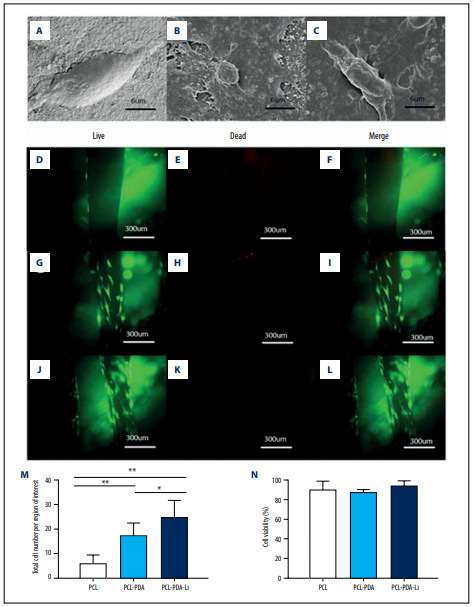 In ‘Lithium Chloride-Releasing 3D Printed Scaffold for Enhanced Cartilage Regeneration,’ researchers from Nanjing Medical University experiment with coated scaffolds for furthering cell regeneration in patients. The authors realized the importance of such a study due to the challenges often encountered in renewing cartilage after physical damage.
In ‘Lithium Chloride-Releasing 3D Printed Scaffold for Enhanced Cartilage Regeneration,’ researchers from Nanjing Medical University experiment with coated scaffolds for furthering cell regeneration in patients. The authors realized the importance of such a study due to the challenges often encountered in renewing cartilage after physical damage.
While lithium is well-known for controlling bipolar disorder, previous research has shown that it may influence lessening the effects of arthritis, as well as preventing cartilage degradation in osteoarthritis. Here, the researchers investigated the use of lithium in creating poly-e-caprolactone (PCL) scaffolds, and then refining them further into a PCL-PDA-Li scaffold – (where the PDA as an abbreviation for polydopamine).
The authors then continued to evaluate the structures for:
- Physiochemical properties
- Bioactivity
- Biocompatibility
They also compared them to PCL scaffolds and PCL-PDA scaffolds upon 3D printing a range of samples. While the pure PCL scaffolds were white (as in the normal color of PCL), PCL-PDA and PCL-PDA-Li scaffolds were dark brown after the researchers applied the PDA coating. The addition of lithium did not change coloration at all in scaffolding. All three scaffolds were smooth, but there were differences in the PCL-PDA scaffolds with small granules, and LiCl crystals attached to the granules in the PCL-PDA-Li scaffolds.
The researchers stated that hydrophilic scaffolds like PCL-PDA and PCL-PDA-Li scaffolds can provide better adherence of cells. There were no obvious disparities between the samples in mechanical properties within this research study. Ultimately, however, the researchers stated that they still found the lithium to be lacking in the desired effect for scaffolding and consequent tissue regeneration.

The morphology and surface microstructure of 3D-printed scaffolds. The lower and higher magnification of digital photographs of PCL (A, B), PCL-PDA (C, D), and PCL-PDA-Li scaffolds (E, F). The corresponding SEM images of PCL (G, H), PCL-PDA (I, J), and PCL-PDA-Li (K, L) scaffolds
“Improvement of scaffolds is needed to provide a better environment for chondrogenesis,” stated the researchers. “Due to the poor expansion capacity, chondrocytes are not an ideal choice for cartilage tissue engineering. BMSCs have an extraordinary potential for proliferation and multipotential differentiation, including chondrogenesis, can be easily harvested by bone marrow.”
Overall upon comparing all the samples, the researchers discovered that PCL has the best strength and biodegradation, making it more suitable for scaffolds.
“We successfully synthesized PCL-PDA-Li scaffolds by 3D printing following a simple 2-step method. PDA coating and LiCl deposition improves surface hydrophilicity without sacrificing mechanical strength. In vitro experiments showed that PCLPDA-Li scaffolds promote better chondrocyte adhesion and cartilage matrix deposition. Our results demonstrate a better method for lithium administration and present a promising scaffold for cartilage tissue engineering,” concluded the researchers.
Tissue engineering today allows for the creation of new cells and structures able to heal patients in need; regeneration of cartilage is one area that is challenging, along with bone regeneration, skin grafts, and scaffolding for breast reconstruction. Find out more about 3D printed scaffolds for enhanced cartilage regeneration here. What do you think of this news? Let us know your thoughts! Join the discussion of this and other 3D printing topics at 3DPrintBoard.com.

SEM micrograph of rBMSCs cultured on the PCL (A), PCL-PDA (B), and PCL-PDA-Li (C) scaffolds for 7 days. Live and dead
staining of rBMSCs cultured on the PCL (D–F), PCL-PDA (G–I), and PCL-PDA-Li (J–L) scaffolds for 14 days. (M) Total cell number
attached on the scaffolds. (N) Quantification of live and dead cells on the scaffolds. (* p<0.05, ** p<0.01)
Subscribe to Our Email Newsletter
Stay up-to-date on all the latest news from the 3D printing industry and receive information and offers from third party vendors.
You May Also Like
Precision at the Microscale: UK Researchers Advance Medical Devices with BMF’s 3D Printing Tech
University of Nottingham researchers are using Boston Micro Fabrication‘s (BMF) 3D printing technology to develop medical devices that improve compatibility with human tissue. Funded by a UK grant, this project...
3D Printing Webinar and Event Roundup: April 21, 2024
It’s another busy week of webinars and events, starting with Hannover Messe in Germany and continuing with Metalcasting Congress, Chinaplas, TechBlick’s Innovation Festival, and more. Stratasys continues its advanced training...
3D Printing Webinar and Event Roundup: March 17, 2024
It’s another busy week of webinars and events, including SALMED 2024 and AM Forum in Berlin. Stratasys continues its in-person training and is offering two webinars, ASTM is holding a...
3D Printed Micro Antenna is 15% Smaller and 6X Lighter
Horizon Microtechnologies has achieved success in creating a high-frequency D-Band horn antenna through micro 3D printing. However, this achievement did not rely solely on 3D printing; it involved a combination...





























